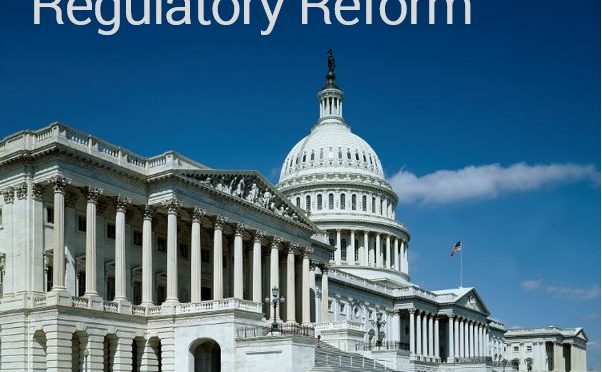Is US Financial Regulatory Reform Dead or Ready for Take Off?
Blog: Enterprise Decision Management Blog

As a result of several recent policy developments, talk of achieving meaningful US financial regulatory reform is getting louder. The passage in the House of the Republican-backed Financial CHOICE Act of 2017 (Choice Act), the ongoing federal agency activity in response to a number of regulatory reform-related Executive Orders by President Trump, and the positive results from the Fed’s annual supervisory stress tests of large banks are examples of efforts that appear to be moving the reform movement forward.
Yet formidable political obstacles remain, leading many to ask: What is achievable and what path will regulatory reform follow? Here is my take.
A Legislative Solution Is Not on the Horizon … at Least Not Any Time Soon
In June, the House adopted, along a party line vote, the Choice Act, which aims to make broad changes to the 2010 Dodd-Frank statute. While Democrats and Republicans have both discussed their willingness to explore regulatory changes such as targeted relief for small and medium-size banks, the Choice Act has a number of provisions that deeply divide the two parties. These include eliminating the proprietary trading restrictions of the ‘Volcker’ Rule, major changes to the Financial Stability Oversight Council and the diminished authority and independence of the Consumer Financial Protection Bureau (CFPB).
Despite the ongoing bipartisan efforts of Senate Banking Committee Chairman Mike Crapo (R-ID) and Ranking Member Sherrod Brown (D-OH), passage of a Senate reform proposal — let alone a compromise bill that could be approved by both chambers — seems elusive.
A Crowded Legislative Agenda
Perhaps an equally daunting challenge is the already crowded legislative agenda, which includes heavy-lift items like healthcare and tax reform and increased infrastructure spending. There are even rumblings of serious work on housing finance reform. Adding to these legislative initiatives are such must-do items as flood insurance, appropriations funding, the FAA Authorization Act, the National Defense Authorization Act and, of course, the lifting of the debt ceiling.
And now there is even more on Congress’s plate. With the recent issuance by the Consumer Financial Protection Bureau (CFPB) of its controversial final arbitration rule, House and Senate Republicans quickly announced their plans to rescind the rule under the Congressional Review Act. Similar efforts, further crowding the legislative calendar, may be pursued if the CFPB moves forward with issuing its final small-dollar lending regulation.
In short, it is hard to see how financial regulatory reform gets any congressional consideration in 2017 or in the foreseeable future. So where does that leave us? Is there any hope for financial regulatory reform?
Federal Agency Action Will Be Key
The promise of realizing any financial regulatory reform likely rests with the federal agencies. The election of a new president has presented President Trump with the opportunity to make sweeping changes within the leadership structure of all the federal agencies, including the independent banking agencies. We have already seen new leaders at the Federal Communication Commission (FCC) and the Securities Exchange Commission (SEC), while the President has recently nominated a new head of the Office of the Comptroller of the Currency (OCC). In the coming months, the President will have the opportunity to nominate new leadership at the Federal Deposit Insurance Corporation (FDIC) and the Federal Reserve, and a year from now at the CFPB.
These changes in leadership will assist in the implementation of the President’s financial regulatory reform agenda. On June 12, policy leaders and the public received a preview of the type of regulatory reform initiatives that the administration supports when Treasury Secretary Steven Mnuchin released a 150 page report on recommended changes to the financial system in response to a February Executive Order. In a recent interview, Mnuchin highlighted the likely path for reform by emphasizing that “about 80 percent of the substance in the report can be accomplished by regulatory changes, and about 20 percent by legislation.”
Where Are the Opportunities for Reform?
There are a number areas where federal agency action could bring about significant regulatory change. Among the reform recommendations highlighted in the recent Treasury report were changes to The Comprehensive Capital Analysis and Review (CCAR) stress test, capitals requirements for globally systemically important banks (G-SIBs) and substantial revisions to the ‘Volcker’, Home Mortgage Disclosure Act, TILA RESPA Integrated Disclosure and Qualified Mortgage regulations. All of these suggested changes, which aim to ease some of the regulatory burden on financial institutions, could be implemented without an act of Congress.
In addition, with industry urging changes to current filing requirements for Currency Transaction Reports and Suspicious Activity Reports, my colleagues at FICO TONBELLER are closely watching the Treasury Department’s review of existing financial crime regulations at the Financial Crimes Enforcement Network (FinCEN) and the Office of Foreign Assets Control (OFAC). Many are also optimistic that new FCC leadership will result in much-needed reform in the area of Telephone Consumer Protection Act (TCPA). The Act and accompanying regulations have significantly chilled the delivery of important, non-telemarketing customer-centric messages via cellphones. Action in this area would be welcome news for many FICO clients that long to utilize modern technology such as FICO’s Customer Communication Service (CCS) to reach their customers through their preferred communication channels.
Is financial regulatory reform dead? Not at all. However, the real forces of change likely reside outside of the halls of Congress. While it might not be as extensive as some are advocating for, financial regulatory reform is already taking shape. Stay tuned.
The post Is US Financial Regulatory Reform Dead or Ready for Take Off? appeared first on FICO.
Leave a Comment
You must be logged in to post a comment.







